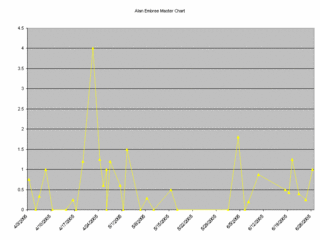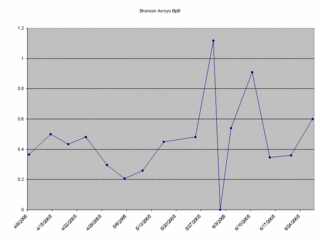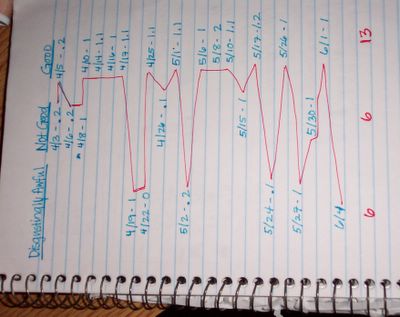Saturday, April 30, 2005
What is BpB?
Due to the enormous amount of interest I have received regarding my pitcher efficiency measurement, I have been meaning to write a more streamlined article defining BpB (Bases per Batter) and explaining it's significance. Evan Brunell of MVN has asked me to write an exclusive guest column on the subject, an honor which I hope will provide more exposure to this unique statistic.
How this all came about...
Necessity is the mother of invention, as they say...
The Red Sox pitching has been somewhat inconsistent this spring. As a fan it has been frustrating, and as a blogger it's been confusing. It's hard to know how to feel about pitchers who are trampled on in one outing, and lights out the next. One reliever in particular has given up game-winning homeruns repeatedly, and naturally the masses have been screaming for his head. In effort to find out just how bad Alan Embree really was, I took a look at his game log three weeks ago, and ended up making a chart:
Jere did not seem content with my silly categories. My friend Lori thought it was hilarious, but I don't think anyone was too impressed. I, however, was fascinated by the visual representation of pitcher performance. The quality of a pitcher's stuff tends to vary from outing to outing. I wanted to chart the performances, and I needed a measurement.
Naturally, I was not content with any of the pitching stats readily available to me. Each stat was good for measuring different things, but none seemed to tell the whole story. I decided to simplify. Every base the pitcher is responsible for giving up would be counted. To be fair, it would be divided by the batters faced. Innings are a good measurement... In a vacuum; One error will skew the numbers. Batters Faced is an easy number to get, and allows for a fair comparison which disregards the circumstances.
Please note that I did this for my own peace of mind. I needed to come to some conclusions about the pitching staff, and simple averages were not going to do it for me. I did not expect to generate this much interest. I was simply pleased with having a way to more accurately depict and assess Captain Cheese's (Embree) performance, among others.
 (click to enlarge)
(click to enlarge)When I started collecting data, I had no idea how useful the breakdown would be. It wasn't until charting my first opposing pitcher (Kevin Millwood, Cleveland) when I realized how much I was learning about him from the types of bases he gave up. By the time I was done, I had a very good sense for the type of pitcher Millwood was. I knew the sox would be stealing (although they hardly ever do) and when Kevin walked two in the first, I knew that was unusual.
Most of the numbers making up the "bases" totals for pitchers are scribbled in a spiral notebook. Some are not written down at all, and I will have to return to the box and get the breakdown. I started including them in my data table when I recently charted the league leaders in Wins, ERA, and Saves. I am anxious to show them to you, as I feel that the breakdown of these bases may be the most helpful aspect of all in this statistic. In fact, much of my time recently has been spent struggling to display this information, to no avail. Clearly I would prefer to be collecting new data for you people, and I curse the makers of MS Excel for making my life so difficult. It will be remedied eventually, and in the meantime at least we have the charts and averages.
The concept behind Bases per Batter (BpB) is quite simple. Pitchers give up bases in a variety of ways. The end result (runs scored) are in fact a function of the timing of these bases. In order to eliminate the factor of luck as much as possible, I am counting each base as a separate event, unrelated to the others that surround it. How many of these events happen in the same inning is a factor of luck. When a pitcher is leaving a lot of men on base during the course of a game, we all know he has been lucky. Likewise, a pitcher who has easy 1-2-3 innings all game but gets rocked in one inning because all the hits (and other various bases) he gives up happen to come in a row... Well we would consider that pitcher unlucky. By counting each base as a separate event, I am trying to level the playing field, so to speak, as statistically speaking, the luck factor is likely to even out over time.
Why I count the things I count
Most statistics keep track of only hitting, or at best include walks. These are the basics we focus on in baseball to produce runs. There are, however, quite a few other ways to advance the bases, and the pitcher is at fault for most of them. Each pitcher has his own unique collection of pitches and tendencies, often leading to a higher than average rate in one of these "gift base" categories. These extra bases given away by the pitcher certainly count in the game, and ought to also count in the pitcher's overall performance evaluation.
Here is a list of the things I count, and why I count them:
Hits- (obviously) hits are counted by the number of bases. Some pitchers give up more extra base hits than others. This is a large factor in games, as it increases scoring possibilities. It is helpful to see in the breakdown how many hits of each type a pitcher gives up, and it's important in the BpB scoring that these hits count proportionately to their effect on the game.
Walks- (also obvious)
HBP- yes, I know sometimes this is a retaliation game, and I care not. We are not in middle school here, boys. Once this guy gets on base, he is just as likely to score as anyone else. Just as often, this is not on purpose, and indicates control issues.
Wild Pitch- Also an indication of control issues which advances runners on base, making them more likely to score.
Balk- A mental mistake made by pitchers, and yes, this also advances baserunners. I would like to think not, but I'm sure we will find that some make this mistake more than others over time.
Errors charged to the pitcher- Some are better at fielding their position than others. This also counts in the game, and ought to count in their overall evaluation.
Pickoffs- A good pick-off move is rare, and the pitcher should be credited for it.
Stolen Bases and Caught Stealing- I have had quite a few objections over this one, particularly from Mets fans. Remember, when I developed this statistic I did it for my own team. Since I have no doubts in the abilities of Varitek and Mirabelli to make a good throw to second, I feel that the stolen base rate is generally a function of the pitch time from wind-up to the plate. This is a particular to the pitcher that influences the opposing team in their attempts to steal, and therefore ought to be charged and credited to the pitcher at the rate in which it affects the game.
Clearly a catcher's abilities come into play with this statistic, and I will pose to you that a catcher's abilities affect many of the other statistics as well, even if not obvious. This is unavoidable, and for the most part impossible to measure. In the area of stolen bases, however, A MLB catcher ought to be able to make that throw when the pitch they get is fast and easy to handle. I am sorry to hear that Mike Piazza cannot make that throw, and all I can say is he ought then not to be catching every day. I am not sure it is worth it to have his bat in the line-up, if it means every single made by the opposing team essentially turns into a double. What this means for Mets pitchers is that we will be unable to tell how good or bad they are at holding runners, unless we look specifically at games caught by someone else. It also means their numbers will be skewed in comparison with pitchers throwing to a decent catcher. This would affect their standings in the event that we actually collect enough data to show the league leaders in BpB, but I find those standings to be fairly meaningless in themselves. From an analytical perspective, we would see this trend in all the Mets pitchers, and therefore not take it very seriously. Stat makers like Baseball Prospectus could surely come up with a catcher rating system to adjust it with as well. From a management perspective, I would look at the catcher's abilities and the wind-up to plate speeds as other factors in analyzing a pitcher's stolen base rate.
Again, I am sorry about Mike Piazza, Mets fans, and hopefully Omar Minaya will see to fit to rectify that situation in the near future. Perhaps a stat like BpB is just the push he needs in order to see the importance of this issue. And I look forward to doing the numbers on Mets pitchers to see just how bad Piazza really is.
Things I don't Count:
Double Plays- actually, I'd really like to credit a pitcher for these, as some are better at getting this type of ground ball out than others. Certainly the skill of the infielders is a factor in this area, but according to statistic guru Bill James, the difference in MLB defenses is fairly negligible. I think this would be a useful stat to see in the breakdown, as it would tell us even more about the pitcher's individual characteristics. Like SB's, a particularly poor defense would likely show up in the team's overall stat breakdown.
The only reason I don't currently count this statistic is because the information is hard to come by. The box scores don't indicate the pitcher for the DP unless he is involved, and it's often impossible to figure out without wading through the play-by-play. If BpB is ever taken on as a popular stat, I certainly hope this will be included, as those calculating would surely have a database of detailed information of this kind. In the meantime, if anyone knows of an efficient way to get this information per outing, please let me know.
Sacrifices- In effort to remove the circumstances from the BpB stat, I have decided against counting sacrifices. I feel that these are more indicative of the number of outs in the inning, and the strategy style of the opposing team. One could argue that just as some pitchers are more likely to get double play balls, others are more likely to give up the sacrifice fly... And that the double play ball also is affected by the number of outs in the inning. These things are true, but I consider the circumstances to be a much greater factor in sacrifices than in any other base awarded or taken away.
The Results
There are three types of results we get from BpB. The average is the typical display of baseball statistics. While it allows us to easily compare the overall performances of different pitchers, I find it to be the least useful of the three. The chart is the visual representation of BpB over time. This, of course, was the inspiration of BpB, and allows us to look at a pitcher's consistency, pick out anomalies, and assess what would be a "normal" outing for a pitcher. I like to use Bronson Arroyo's chart here, as it gives us a good example for both the type of consistency and anomaly we are looking for:
(click to enlarge)
 The breakdown is the specifics regarding the types of bases a pitcher gives away. This not only tells us a great deal about a pitcher's individual strengths and weaknesses, it can also show areas where other stats like ERA are affected by team weaknesses (i.e. the Mike Piazza situation.) I look forward to showing some data tables of the breakdown in the near future, as it really is fascinating. I would also like to eventually incorporate the breakdown elements in the charts, by color-coding the various elements, and charting them within the area of the total BpB rate. (Since I am, shall we say, less than an expert in computer programs, this will also take me awhile to figure out how to display.) In the meantime, I will try to point out areas of significance with particular pitchers.
The breakdown is the specifics regarding the types of bases a pitcher gives away. This not only tells us a great deal about a pitcher's individual strengths and weaknesses, it can also show areas where other stats like ERA are affected by team weaknesses (i.e. the Mike Piazza situation.) I look forward to showing some data tables of the breakdown in the near future, as it really is fascinating. I would also like to eventually incorporate the breakdown elements in the charts, by color-coding the various elements, and charting them within the area of the total BpB rate. (Since I am, shall we say, less than an expert in computer programs, this will also take me awhile to figure out how to display.) In the meantime, I will try to point out areas of significance with particular pitchers.
I really appreciate all the interest, comments, and questions I have received regarding BpB so far. I do not consider myself to be any sort of expert on stats, and in fact have learned a great deal from comments so far. I would like to thank Alan Embree for inspiring me to come up with this stat, despite the circumstances under which he has done it.

